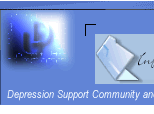|
|
Information Centre > Articles And Essays >
Depression
[<
Back] [Read
Reviews]
[Write A Review]
"What Are Depression,
Anxiety and Panic?" by Jammy Hokins
| Article ID: #D011
What Are Depression, Anxiety
and Panic?
Introduction
We wish to start this section with a clear definition of what we mean by
the terms depression, anxiety and the very high levels of sudden-onset
anxiety known as panic.
Together, these affect more than one in five people at some time in their
lives.
What is depression?
Feeling fed up and low in mood is a normal part of life. When difficulties
or upsetting events occur it is not unusual to feel down, stop enjoying
things and to feel understandably low for a time as a reaction to these
events.
Likewise when good things happen, a person may experience happiness,
pleasure and a sense of achievement. The reasons for low mood are usually
clear - a stressful situation, a relationship difficulty, feeling let down
by someone, financial difficulties, unforeseen events or some other
practical problem.
Most of the time the drop in mood only lasts for a short period of time
and then we "bounce back".
Occasionally, however, a person's mood may seem to fall for little or no
obvious reason and it may be difficult to begin with to know quite why. In
some cases this "depressed" feeling can worsen and completely dominate the
person's life. When someone feels very low for more than two weeks and
feels like this day after day, week after week, this is called a
depressive illness.
It is important to say that there should no stigma attached to the
diagnosis of "depression". In reality the term is simply a convenient way
of describing a broad range of symptoms that vary from person to person
but are having an unhelpful impact on their lives.
b). What is anxiety?
Anxiety, worry, tension and stress are all terms that are used to describe
what is a widespread experience for many people. Anxiety is a common
emotion, which at times can be helpful even though it can feel very
unpleasant.
For example, in situations of danger we begin to feel anxious and this
prompts us to try to deal with it by getting away as rapidly as possible.
If you walk along a badly maintained path next to a large drop, anxiety
can be life saving, appropriate and helpful.
However, sometimes anxiety can occur inappropriately and then it becomes
unhelpful. The person may feel anxious in situations that are not really
dangerous at all, or notice excessive anxiety well beyond what is actually
helpful or appropriate in the circumstances.
Worrying thoughts are common in anxiety. In worry, the person goes over
things again and again in their mind in a way that is unhelpful because it
does not actually help to resolve the difficulty that is being worried
about. Instead, problems are turned over and thought about again and
again.
Sometimes the worry may be out of all proportion; something that may
originally have happened in a few moments, perhaps something that someone
has said to you, can dominate your thinking for much of the following days
or weeks, adding up in total to many days or even weeks of worry over the
following months.
In anxiety, the person often overestimates the threat or danger they are
facing, and at the same time usually underestimates their own capacity to
cope with the problem.
Normally, when there is no stress, the person feels able to cope with the
problems they face. In other situations, they may begin to feel stressed.
Either they see the problem as too large or overwhelming, or they think
they cannot cope.
In both situations, the anxiety balance is upset, and the person begins to
feel increasingly stressed and upset. At times of emotional distress, it
is sometimes easy to forget that we are not alone when we face life's
difficulties - we do not only have our own capacity to cope, but also upon
the support of others around us including friends, relatives, voluntary
sector groups and health care practitioners such as your GP as well as
those working within the mental health services..
c). What are panic attacks?
Sometimes anxiety can come on very rapidly (usually within 10 minutes) to
such a high level that the person feels so mentally and physically tense
and unwell that they stop what they are doing and try to leave or escape
from the situation. Failing that they may become paralysed into inactivity
like rabbits caught in the headlamps of a car and just wait, expecting
disaster to strike at any moment.
They do this because they fear that something terrible or catastrophic
will happen. This feeling of acute fear, dread or terror is called a panic
attack.
Panic attacks typically have a rapid onset and are short-lived, usually
lasting no longer than 20-30 minutes. During panic, the person can
experience catastrophic fears that a sudden and threatening physical
illness or terrible event will occur right now.
"I'm going to faint", "I'm going to suffocate" "I'm going to collapse",
"I'm going to have a stroke", or "I'm going to have a heart attack", are
the sorts of thoughts that will go through their minds.
Sometimes the fear is that a catastrophic mental event will occur such as
going mad and losing control. These fears may take the form of a mental
image (for example, a picture of losing control or of being admitted to
hospital with a heart attack).
Sometimes fears may be focused upon the reaction of others (e.g. a fear
that others will look and laugh or mock you if you were to collapse).
The key point is that the fear is immediately threatening, scary and
catastrophic. Sometimes the person becomes so fearful that even just
thinking about the situations and places where panics have previously
occurred may result in them feeling anxious.
They may find themselves worrying that a further panic attack will occur
and this anticipation itself can add to the person's anxiety. The person
commonly reacts by avoiding anything to do with that situation or place.
The result is often an increasingly restricted lifestyle, reduced
confidence and additional long-term distress. When this happens, the
person is described as having a phobia as well as panic attacks.
A phobia is anxiety that regularly occurs in a specific situation. You may
have heard of people who have panic attacks on buses or in shops or
crowded situations - the most common form of phobia and is sometimes
called agoraphobia.
Panic attacks also commonly occur in other specific situations (in open
spaces, and in phobias of certain animals such as spiders and snakes, and
even such apparently harmless creatures as butterflies).
In some cases the person may not have a specific fear or anxiety but
experience panic attacks when other upsets or fears build up and up in
their minds. It is important to realise that problems of anxiety,
depression and panic may occur together, or quite separately.
However they are affecting you, this chapter will help you to find out
more about the causes of these, and help you to begin to plan ways of
changing this. How common are depression, anxiety and panic?
Depression and anxiety are far more common experiences than most people
think. Anxiety and depression can affect anyone.
Some well known people have experienced them. You may have seen television
programmes or read books about their experience of tackling these
problems. Around 1 in 5 people experience depression and at least 1 in 10
people experience a panic attack at some time in their lives.
It is extremely likely that you will know one or two friends, family
members or people you come across on a daily basis who regularly
experience these problems.
There will probably be many more people around who are suffering from
depression, anxiety and panic than you are aware of because of the
unwillingness of many people to admit having such experiences.
|
About The Author
Jammy Hokins writes for
http://www.anxietyremedies.info where you can find out more about
cheap hotels and other topics. |
[<
Back] [Read
Reviews]
[Write A Review]

[Back
To Top]
|



